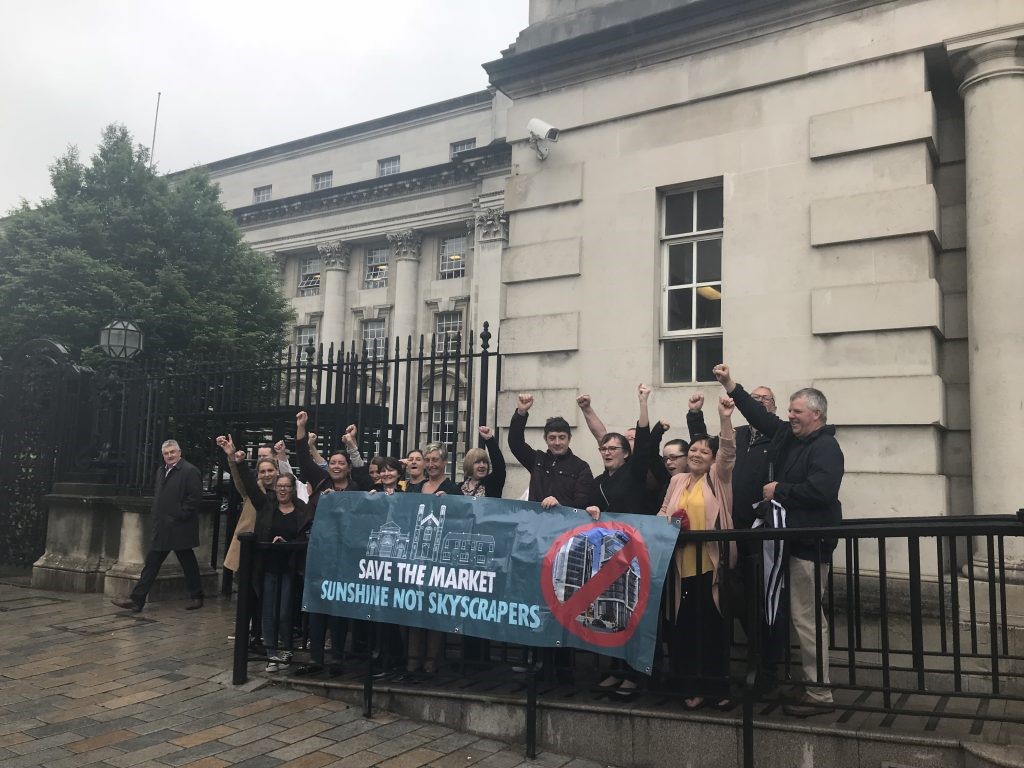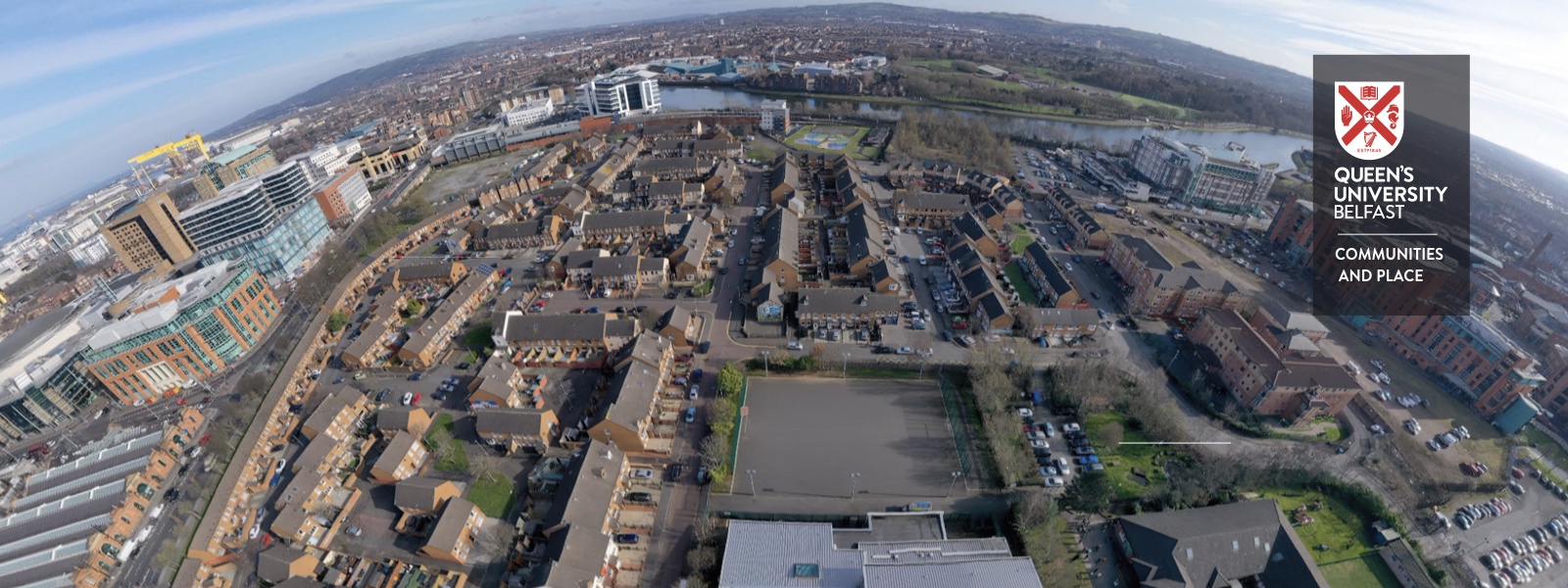The Market Community
The pilot partner community for QCAP is the Market in Inner South Belfast. The Market is one of the oldest working-class communities in Belfast. Located on the banks of the Lagan, it is historically linked to the city’s industrial revolution in the 19th century. Housing was built for those working in waterfront businesses such as factories, distilleries, abattoirs, and several markets including the famous St George’s, which survives to this day. Through this thriving commercial landscape grew a community, which benefited from the available jobs and the abundant fresh food. Unfortunately, Belfast suffered serious decline beginning in the 1960s which was greatly exacerbated in the 1970s and 80s by the civil unrest of the ‘Troubles’. The conflict impacted the Market and other inner-city working-class communities whose traditional occupations were lost. Gradually many of these communities were lost to city centre shopping and financial development, while their residents moved out to housing estates on the outskirts of the city.
The Market community was also significantly impacted by strategic planning decisions taken to disperse the commercial and industrial activity out of the city centre and across the country. Despite the difficulties and decline of the area the residents developed their own plan for community regeneration in 1973, though the agreed upon development did not materialise. What ultimately materialised was the Lanyon Place Complex and several other large-scale developments surrounding and encroaching on the Market area, which brought financial investment and benefits back to Belfast, though the community was largely locked out of those benefits both socially and physically.
A community-led survey published in 2019 collected the views of 226 residents over the age of 16 providing the views of the community on six specific human rights indicators. Overdevelopment, road safety, housing, health, education, and employment. This existing evidence provided QCAP and the community partners with a starting point from which to develop goals and priorities. For example, 94% of those surveyed felt that commercial over-development posed a threat to the future of the Market (Hargey, 2019). Prior even to the collection of this data strong involvement in activism clearly demonstrated the community’s views, wherein the residents have championed campaigns directed to the preservation of the historic sites, retention of community assets, and prevention of damaging development.
A key example of this community led action was the ‘sunshine not skyscrapers’ campaign which protested the proposed building of a 14-story skyscraper next to two story family homes The proposed build would have blocked light from these homes for a significant portion of the day and was planned on a site which would have impacted access to the historic east bridge tunnels. The east bridge tunnels pass under the road and in the past connected the community to the city centre. During the large-scale commercial development of Lanyon Place including the building of the Waterfront and the Hilton Hotel, the tunnels were closed off with the justification being that people living in the market community presented a threat to the desired patrons of the Lanyon Place complex. The campaign to prevent the skyscraper being built at the Stewart Street site was successful at the high court but continued threats of overdevelopment necessitate that activism be ongoing.

The anchor community partner of QCAP is the Market Development Association (MDA). The MDA was established in 1995 to promote the well-being of all residents living in the Market area of South Belfast and it aims to develop the community into one where people want to live, work, and socialise. The MDA engages with statutory agencies, government departments, political representatives, the private sector, and other stakeholders to advance the development of the Market area into a vibrant and sustainable inner-city working-class community. QCAP recognises the strengths already present in the work of the MDA and are working to support the organisation to increase capacity while building on the existing assets. The community is characterised by a strong sense of cohesion and close family bonds, with many extended families remaining close to each other within the area. Unfortunately, there is ongoing concern about sufficient housing to allow young people to remain living in the area when they leave home and increasing concerns about the allocation of social housing in the area. As in many working-class communities, in recent decades there have been social changes that have impacted the close connections that were previously enjoyed.
Partnership relationships in community-led working take time to develop and require the building of trust, especially given the history of egregious acts carried out by research institutions against research participants (Mullans et al., 2020). Communities have memories and histories, and, in disadvantaged areas, this often includes a catalogue of failures and missed opportunities on the part of government and institutions. Short-term or ineffective interventions therefore lead to a lack of trust and potential reluctance to engage with future projects (Cochran et al., 2008). QCAP is highly aware of the sensitivity of this collaboration and the need to begin and proceed with a culture of respect as detailed in our Community Engagement Charter. As was stated in a Lankelly Chase historical review of place-based approaches, “Beginning work in an area requires a commitment to learning about the place and respect for what is already there […] too many past approaches have failed on this count […] the sensitivity and skill with which a funder uses local knowledge is the most important aspect of best practice” (Taylor, Buckley and Hennessy, 2017).
Demographic data on the market comes from the 2011 census and the 2021 census which has not been published in full at the time of writing, therefore we have utilised data from both as indicated below. Today the community comprises approximately 1981 individuals according to the 2021 census data (NISRA, 2024). Most residents are ethnically white 86.27% and identify within the nationality of Irish only (52.65%) or Northern Irish only (16.73%) a smaller proportion of residents in the market identified as British only (11.07%). Other than White the next most common ethnicity in the Market area was Indian (6.46%) (NISRA, 2023). (n.b. These figures reflect NISRA data zones, through which we can approximate the neighbourhood of the Market, though they are likely to include streets that Market residents would not define as within their area.) This ethnic make-up differs from the rest of NI which is 96.55% white, and in terms of national identity, 19.78% identified as Northern Irish, 29.13% as Irish, and 31.86% as British (NISRA, 2023).
Census data indicate that in 2011 32.62% residents had no qualifications, which was higher than NI overall at 29.12% (NISRA, 2023). Based on this same census data 758 residents (29.41%) were “economically inactive,” again higher than NI overall (24.5%). Additionally, among residents of the Market, only 95 individuals (3.69%) reported being a student, which was substantially lower than the rest of NI (6.18%).
On the health status of residents of the community, the 2011 census indicated 28.72% of residents in the Market reported being in good health, lower than what was observed for NI overall (31.79%). On the other end of the spectrum 2.72% reported being in very bad health. This was higher than what was observed for NI overall (1.19%). Data for mental health suggests that the prevalence of “emotional, psychological, or mental health” conditions is nearly twice as high for the Market (16.5%) as what was observed for NI overall (8.68%) (NISRA, 2024).
Taylor, M., Buckley, E. and Hennessy, C. (2017). Historical review of place-based approaches. Lankelly Chase. https://lankellychase.org.uk/wp-content/uploads/2017/10/Historical-review-of-place-basedapproaches.pdf
Cochran, P.A., Marshall, C.A., Garcia-Downing, C., Kendall, E., Cook, D., McCubbin, L. and Gover, R.M.S., 2008. Indigenous ways of knowing: Implications for participatory research and community. American journal of public health, 98(1), pp.22-27.
Hargey, F. (2019) We Must Dissent: A framework for community renewal. Market Development Association.
Mullins, C.D., Tanveer, S., Graham, G. and Baquet, C.R., 2020. Advancing community-engaged research: increasing trustworthiness within community-academic partnerships. Journal of comparative effectiveness research, 9(11), pp.751-753.
Northern Ireland Statistics and Research Agency (NISRA) (2017)
Northern Ireland Statistics and Research Agency (NISRA) (2024)

